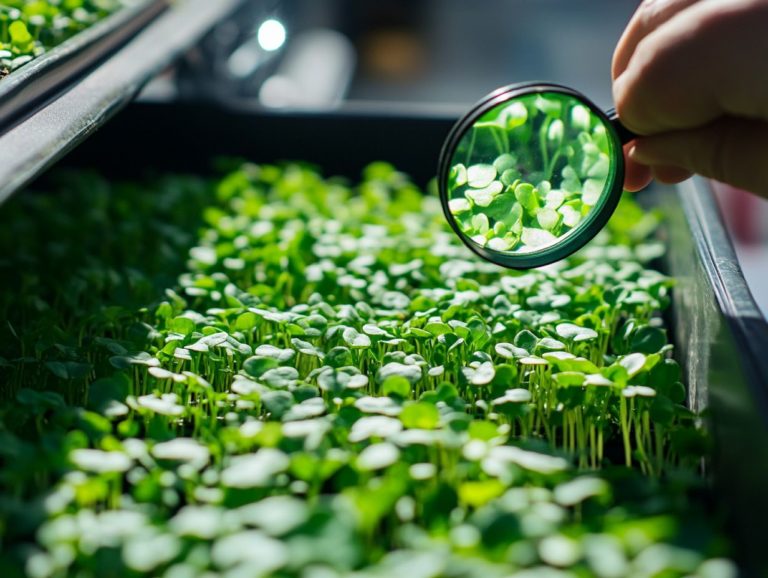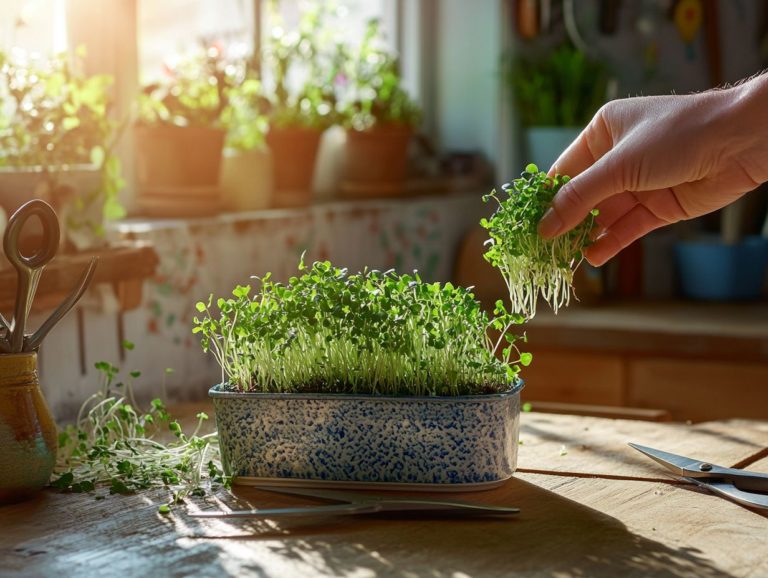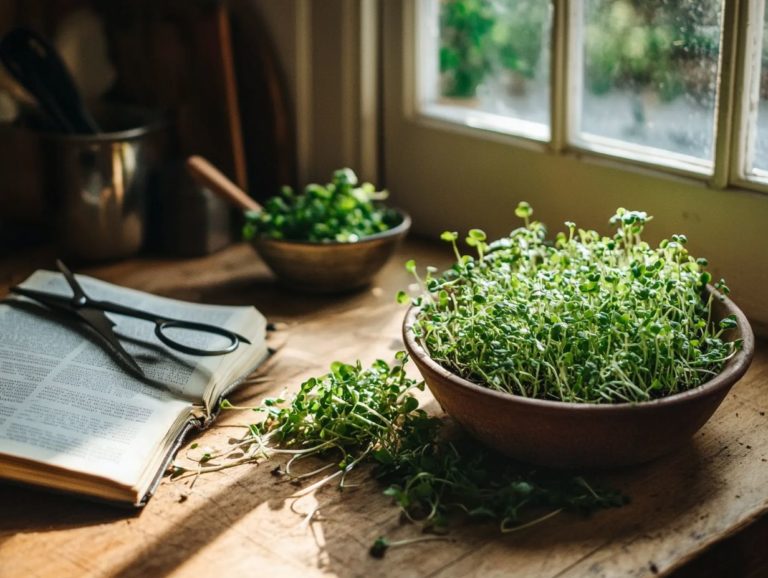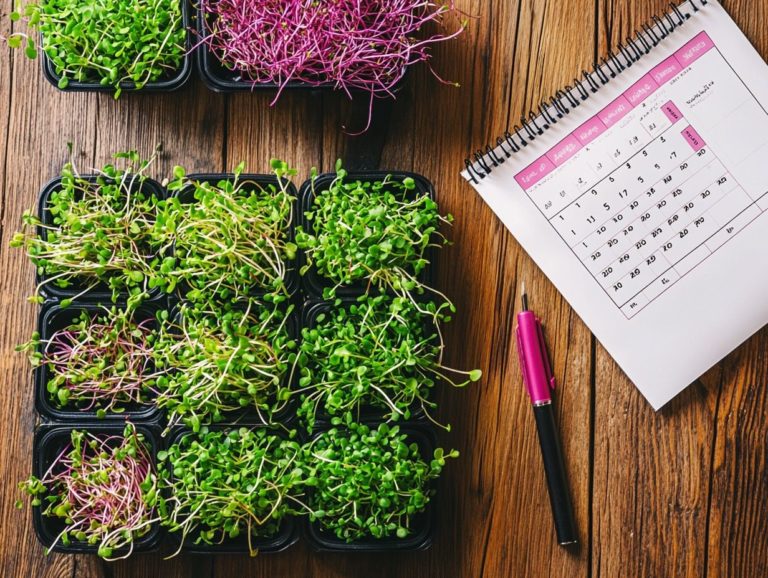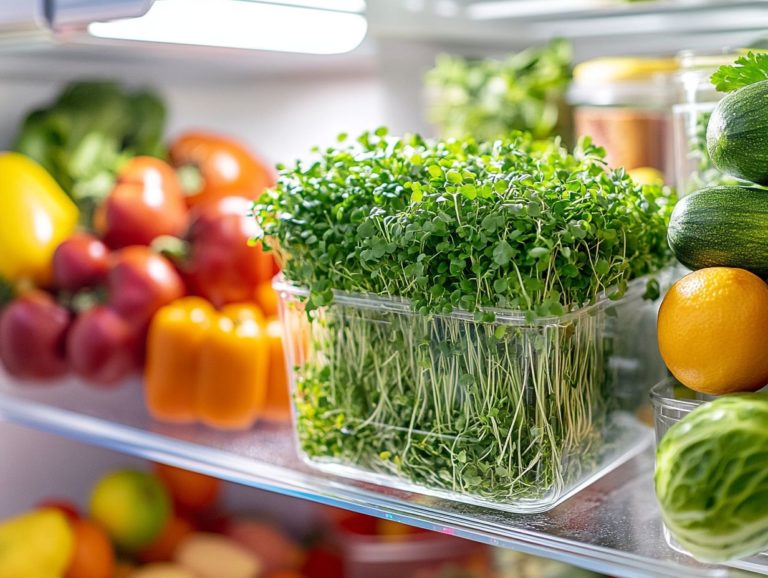The Best Microgreens to Grow for Storage
Microgreens are remarkable little powerhouses filled with nutrients that can elevate your culinary creations and enhance your overall health.
This article delves into the best microgreens for storage, guiding you in selecting varieties that preserve their freshness and flavor over time. From well-loved options like pea shoots and sunflower shoots to intriguing choices such as garlic and fennel microgreens, you ll uncover effective methods for storing and utilizing these greens.
Continue reading to enrich your kitchen repertoire and fully capitalize on your microgreen harvest!
Contents
- Key Takeaways:
- 2. Choosing the Right Microgreens for Storage
- 3. Pea Shoots
- 4. Sunflower Shoots
- 5. Radish Microgreens
- 6. Broccoli Microgreens
- 7. Cabbage Microgreens
- 8. Mustard Microgreens
- 9. Red Amaranth Microgreens
- 10. Buckwheat Microgreens
- 11. Cilantro Microgreens
- 12. Wheatgrass Microgreens
- 13. Fennel Microgreens
- 14. Garlic Microgreens
- Frequently Asked Questions
Key Takeaways:
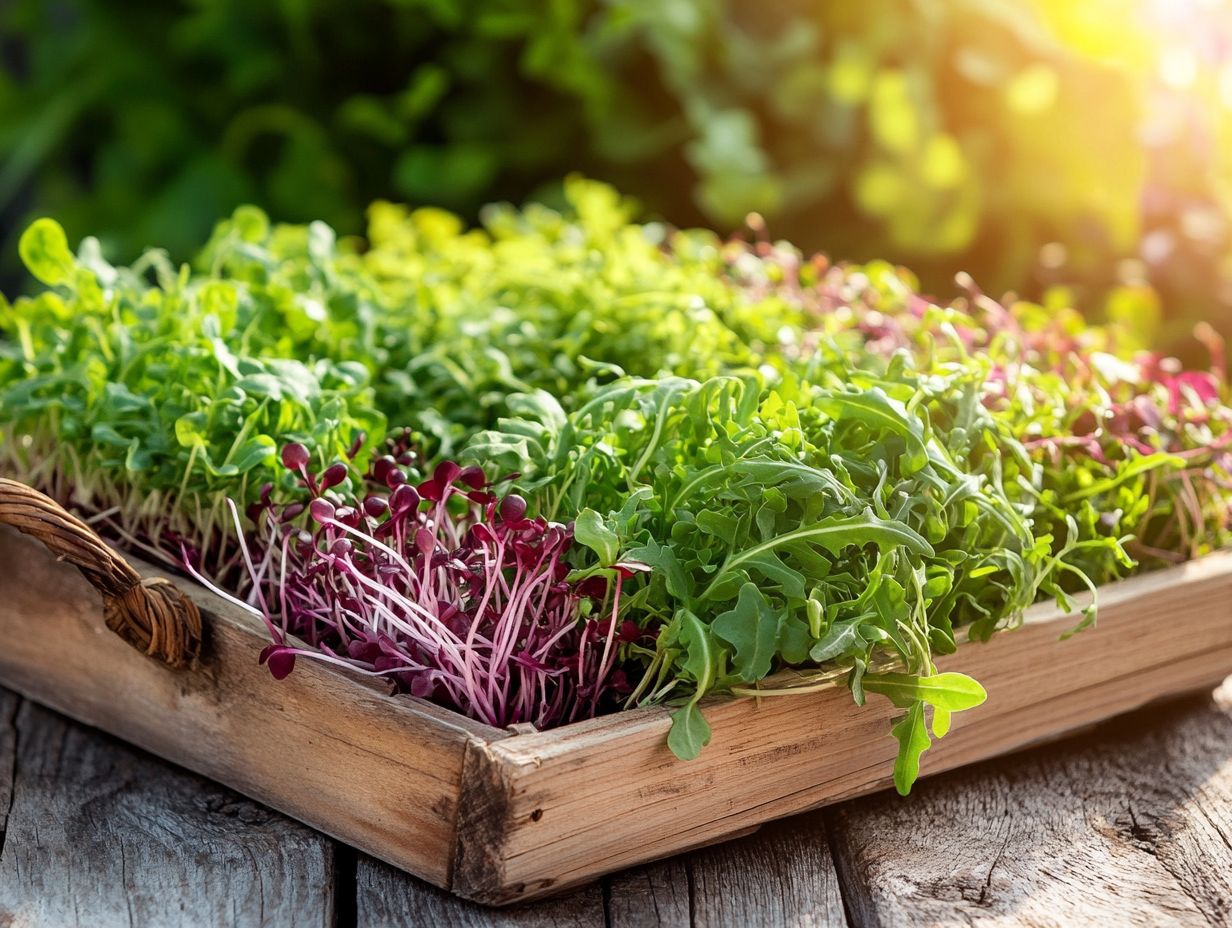
- Consider the type and storage potential of microgreens before choosing which ones to grow for storage.
- Pea shoots, sunflower shoots, and radish microgreens are some of the best options for long-term storage.
- Proper storage methods, such as refrigeration and using an airtight container, can help extend the shelf life of microgreens.
2. Choosing the Right Microgreens for Storage
Selecting the right microgreens for storage means evaluating their flavor and growth patterns. This ensures you enjoy fresh greens and reduce waste.
Consider the growing conditions. Some varieties thrive indoors, while others need sunlight. Understanding their shelf life will help you use them in your meals.
For example, arugula microgreens offer a delightful peppery kick that elevates salads and sandwiches. Meanwhile, sunflower microgreens bring a nutty, crunchy texture that s perfect for topping a variety of dishes. Heirloom microgreens add a unique twist to your culinary creations, showcasing an array of flavors and colors.
By being selective about the types you choose, you can elevate any dish and significantly reduce spoilage.
3. Pea Shoots
Pea shoots rank among the most beloved microgreens, cherished for their tender texture and sweet flavor. They transform salads and sandwiches into extraordinary dishes while offering impressive nutritional benefits.
These vibrant green shoots thrive best in well-drained soil and need a moderate amount of light around 12 to 16 hours per day to unlock their full growth potential.
They’re packed with vitamins A, C, and K, as well as essential minerals like iron and magnesium. This makes them a valuable addition to your diet.
Once harvested, it s vital to store them properly. Keeping them in a breathable container in the refrigerator can maintain their freshness for up to a week.
Incorporating these delightful shoots into various dishes enhances flavor and enriches the nutritional profile. Whether you sprinkle them atop creamy pasta, blend them into a vibrant smoothie, or layer them within tacos for that perfect crunch, they re sure to elevate your culinary creations.
4. Sunflower Shoots
Sunflower shoots are not just a delightful addition to your meals; they re also a powerhouse of nutrients, making them an ideal choice for anyone keen on enhancing their culinary creations with vibrant flavors and essential vitamins.
These delightful microgreens feature a satisfying crunch and a subtly nutty flavor that can elevate various dishes to new heights.
Grown using a method of growing plants in water without soil, they flourish in controlled environments, ensuring optimal growth without the need for soil. This technique allows for quicker harvests and cleaner shoots, appealing to both novice and seasoned growers alike.
To keep them fresh and crisp, store sunflower microgreens in a damp paper towel within an airtight container in the fridge. Their versatility truly shines in salads, sandwiches, and wraps, where they pair beautifully with ingredients like avocado, citrus, and roasted meats, adding a healthy twist to any meal you create.
5. Radish Microgreens
Radish microgreens are celebrated for their peppery flavor and crisp texture, making them a delightful addition to any dish while offering a wealth of essential nutrition.
These tiny greens are packed with vitamins A, C, and E, along with a variety of antioxidants and minerals such as potassium and magnesium. Not only do they elevate the taste of salads and sandwiches, but they also contribute significantly to your overall health.
To achieve ideal growing conditions, you ll want a well-drained soil mix, ample light, and temperatures between 60 F and 70 F. This environment fosters robust growth in a mere 7 to 14 days. Once harvested, store them in the refrigerator in a sealed container to keep them fresh.
Their versatility allows for incorporation into a wide range of dishes, from garnishing soups to blending seamlessly into smoothies, demonstrating their impressive culinary potential.
6. Broccoli Microgreens
Broccoli microgreens are a true nutritional powerhouse, bursting with vitamins A, C, and K. If you re a health enthusiast looking to elevate your dietary intake of essential vitamins, these little greens are an exceptional choice.
Packed with antioxidants and a generous amount of d dietary fiber, they also promote digestive health, making them an all-around winner. To grow them successfully, you ll need a well-draining tray, high-quality seeds, and a warm environment with plenty of light to ensure they thrive.
Once you’ve harvested your microgreens, keeping them fresh is crucial. Store them in a breathable container in the refrigerator to maintain their crispness for several days. For optimal freshness, it’s essential to understand microgreen shelf life. Incorporating these vibrant microgreens into salads, smoothies, or as a garnish on soups not only boosts nutrition but also enhances flavor, allowing you to unleash your culinary creativity!
7. Cabbage Microgreens

Cabbage microgreens, including the striking red cabbage variety, are a feast for the eyes and a crunch that delights the palate. They re a nutritional powerhouse, making them a superb addition to your culinary repertoire.
These vibrant greens are packed with vitamins A, C, and K, along with antioxidants that support your overall health. Varieties like Savoy, Napa, and Bok Choy each bring their own unique flavors and textures to the table, elevating everything from salads to sandwiches.
Growing them is a breeze; they flourish in well-draining soil and need consistent moisture and light to thrive. To enjoy their freshest taste and extend their shelf life, store cabbage microgreens in an airtight container in your refrigerator. Keeping them away from moisture will help preserve their crispness and dazzling color.
8. Mustard Microgreens
Mustard microgreens are truly a delight, known for their bold and spicy flavor that can elevate a myriad of dishes while also offering a treasure trove of essential nutrients.
These petite greens spring from various mustard varieties, each delivering its own unique taste and nutritional perks. For instance, you ll find that black mustard boasts a sharper bite, while yellow mustard offers a milder, tangy profile. Green mustard microgreens, on the other hand, bring a peppery note reminiscent of arugula. They not only enhance salads and sandwiches but are also brimming with vitamins A, C, and E, along with minerals like calcium and magnesium.
To cultivate these vibrant microgreens, make sure they thrive in well-drained soil with plenty of sunlight. Once you’ve harvested them, refer to these tips for washing and storing microgreens and store them in a breathable container in the fridge, ensuring they remain fresh and flavorful for as long as possible.
9. Red Amaranth Microgreens
Red amaranth microgreens not only bring a vibrant splash of color to your meals. They offer a delightful sweet, earthy flavor and an impressive nutritional profile.
These tiny greens thrive in soil that drains well and receives plenty of sunlight. This results in a robust growth pattern that is packed with nutrients. Rich in vitamins A, C, and K, they also include essential minerals and antioxidants, making them a powerhouse for your overall health.
For optimal storage, keep them in a breathable container in the refrigerator. They ll maintain their freshness for several days. You can easily:
- Sprinkle them on salads
- Blend them into smoothies
- Garnish soups
These vibrant microgreens are truly a versatile addition to any dish.
10. Buckwheat Microgreens
Buckwheat microgreens are not just nutritious; they re a feast for the eyes and a delightful addition to your culinary repertoire. With their unique taste, they can elevate salads and various dishes while being remarkably easy to grow in your home garden.
These tiny greens burst with essential vitamins, minerals, and antioxidants. Their subtly nutty flavor brings depth to your meals, perfectly complementing both raw and cooked preparations.
For optimal growth, these microgreens flourish in well-draining soil and bask in sunlight, requiring only minimal care and space. Once you’ve harvested them, proper storage becomes essential. Keeping them in a breathable container in the refrigerator will preserve their freshness and vibrant flavors, making them a delightful touch to every meal you create. To enhance your culinary creations, explore the top microgreen varieties for gourmet cooking.
11. Cilantro Microgreens
Cilantro microgreens elevate your culinary creations with a vibrant burst of fresh flavor. They are celebrated not just for their taste but also for their impressive health benefits. They re an essential addition to any kitchen for those who truly appreciate the art of cooking.
Growing these tiny leaves at home is remarkably straightforward. They require minimal space and flourish on a sunny windowsill or in a container garden. Rich in essential vitamins A, C, and K, along with antioxidants, cilantro microgreens enhance your dishes and contribute to your overall health, making them a perfect companion for:
- Salads
- Tacos
- Soups
To maintain their maximum freshness, store your cilantro microgreens in a damp paper towel within a plastic bag in the refrigerator. This simple trick keeps them crisp for an extended period. For those who love to experiment, consider sprinkling them atop your dishes or incorporating them into sauces to add an extra layer of flavor that delights the palate.
12. Wheatgrass Microgreens
Wheatgrass microgreens are celebrated not only for their unique flavor but also for their impressive health benefits. With high concentrations of vitamins and minerals, health-conscious individuals love them!
These nutrient-rich greens are loaded with vitamin C, vitamin E, and various B vitamins, alongside essential minerals like iron, calcium, and magnesium. The health advantages they offer are truly impressive. Cultivating them doesn t require a green thumb; they flourish in well-drained soil and thrive with ample sunlight and consistent moisture.
After harvesting, you can store these microgreens in a cool, dry place, but they are best enjoyed fresh to maximize their nutritional benefits. Incorporating them into your daily meals is easy; just consider the top 10 microgreens for nutritional boost.
- Blend them into your smoothies for a nutritious boost
- Sprinkle them on salads for that extra crunch
- Use them as a vibrant garnish for soups
They enhance both the flavor and the visual appeal of your dishes, making your meals not just healthier but also more delightful.
Don t miss out on the chance to enhance your meals with these flavorful microgreens! Try growing your own at home or check out more recipes that utilize these greens.
13. Fennel Microgreens

Fennel microgreens bring a mild, anise-like flavor and a wealth of nutritional benefits to your table. They are a fantastic choice for giving salads and other dishes a unique twist.
These tiny greens are not just a pretty garnish; they re packed with vitamins A, C, and K, plus a bounty of antioxidants that support your overall health. They thrive in well-draining soil enriched with organic matter, preferring moderate light and cozy temperatures between 60 and 75 F.
If you’re cultivating them at home, keep the soil consistently moist without letting it become soggy. After harvesting these gems, store them in a sealed container in the refrigerator. This keeps them fresh for about a week, allowing you to savor their delightful flavor and health benefits whenever you please.
14. Garlic Microgreens
Garlic microgreens offer a subtle, mild garlic flavor along with impressive nutritional benefits. They enhance your culinary creations beautifully.
Thriving in a well-drained soil mix and basking in ample sunlight or grow lights, these microgreens flourish best in temperatures ranging from 60 F to 75 F. To maintain their freshness, it’s also important to know the best storage temperature for microgreens. Their unique flavor profile boasts a delicate hint of garlic, devoid of the pungency found in mature cloves. This makes them perfect for elevating salads, sandwiches, and even soups, adding depth without overwhelming other ingredients.
To keep them fresh, store garlic microgreens in a sealed container in your refrigerator. They can last up to a week. For those interested in easy harvesting, check out the top 5 microgreens for easy harvesting. This keeps them fresh and ready for all your culinary adventures!
What Are Microgreens and Why Are They Good for Storage?
Microgreens are young, packed with nutrients plants celebrated for their vibrant flavors. They are not just a culinary delight but also an excellent choice for storage due to their impressive shelf life when handled correctly.
These petite greens include a variety of types, such as arugula, radish, and basil. Each brings its own unique taste profile that can elevate any dish. Their rich nutritional content, brimming with vitamins and antioxidants, positions them as true powerhouses in your meals, often outshining their mature counterparts.
It’s no wonder that both home cooks and professional chefs seek out microgreens. They deliver a burst of flavor while enhancing the health benefits of any dish. Their straightforward growth requirements make them easy to grow, whether you have a spacious backyard or just a sunny windowsill. To maximize your success, consider using the best substrates for microgreen growing. They’ve become increasingly popular!
What Factors Should Be Considered When Choosing Microgreens for Storage?
When selecting microgreens for storage, consider key factors like shelf life, flavor profiles, and growth patterns. This ensures you maximize both freshness and culinary delight.
Understanding the unique characteristics of each microgreen variety is crucial. For example, varieties like pea shoots or sunflower have a longer shelf life and provide a delightful crunch, making them perfect for a variety of dishes. After harvesting, it’s important to know what to do with microgreens to maximize their freshness and flavor.
In contrast, more delicate greens such as basil or arugula deliver intense flavors but may wilt more quickly. The growing methods you choose hydroponic (growing plants in water without soil) or soil-based can greatly affect how long these greens remain suitable for consumption.
Proper harvesting and storage techniques are essential for maintaining freshness. This emphasizes the importance of paying careful attention throughout the entire growing and processing cycle.
How Do Different Types of Microgreens Fare in Storage?
Different types of microgreens have unique storage capabilities. Some retain their nutritional value and flavor profiles longer than others, influenced by factors like moisture and light exposure.
Take broccoli microgreens, for example. When stored correctly, they can stay fresh for up to two weeks. On the other hand, radish sprouts, with their delightful zing, typically last about a week. For health enthusiasts, sunflower microgreens, known for their hearty texture, also hold up for around seven days. You can explore more about the top microgreen varieties for health enthusiasts to enhance your diet.
To make the most of your microgreens, it s crucial to keep them in a cool, dark space with adequate airflow. Using breathable containers helps manage moisture levels effectively. Damp paper towels can provide just the right amount of humidity to extend their shelf life even further.
By comparing these types, you ll notice significant differences in longevity, emphasizing the importance of understanding each microgreen’s unique storage needs.
What Are the Best Storage Methods for Microgreens?
To preserve the freshness and nutritional value of microgreens, it s essential to employ the best storage methods. Use airtight containers and keep moisture levels in check to ensure their delightful flavors and vibrant colors remain intact.
Refrigeration works well. The cool environment slows down degradation, keeping your greens crisp and ready for use. Storing microgreens in airtight containers prevents exposure to excess air, which can lead to wilting and nutrient loss.
Don’t overlook Moisture control; ensure the greens are dry before sealing them away, as excess moisture can invite mold and spoilage.
When you apply these storage strategies correctly, your microgreens stay fresh for an extended period. To maximize your harvest, consider the most profitable microgreen varieties to grow for even more flavorful and nutritious meals!
How Can Microgreens Be Used in Everyday Cooking and Storage?
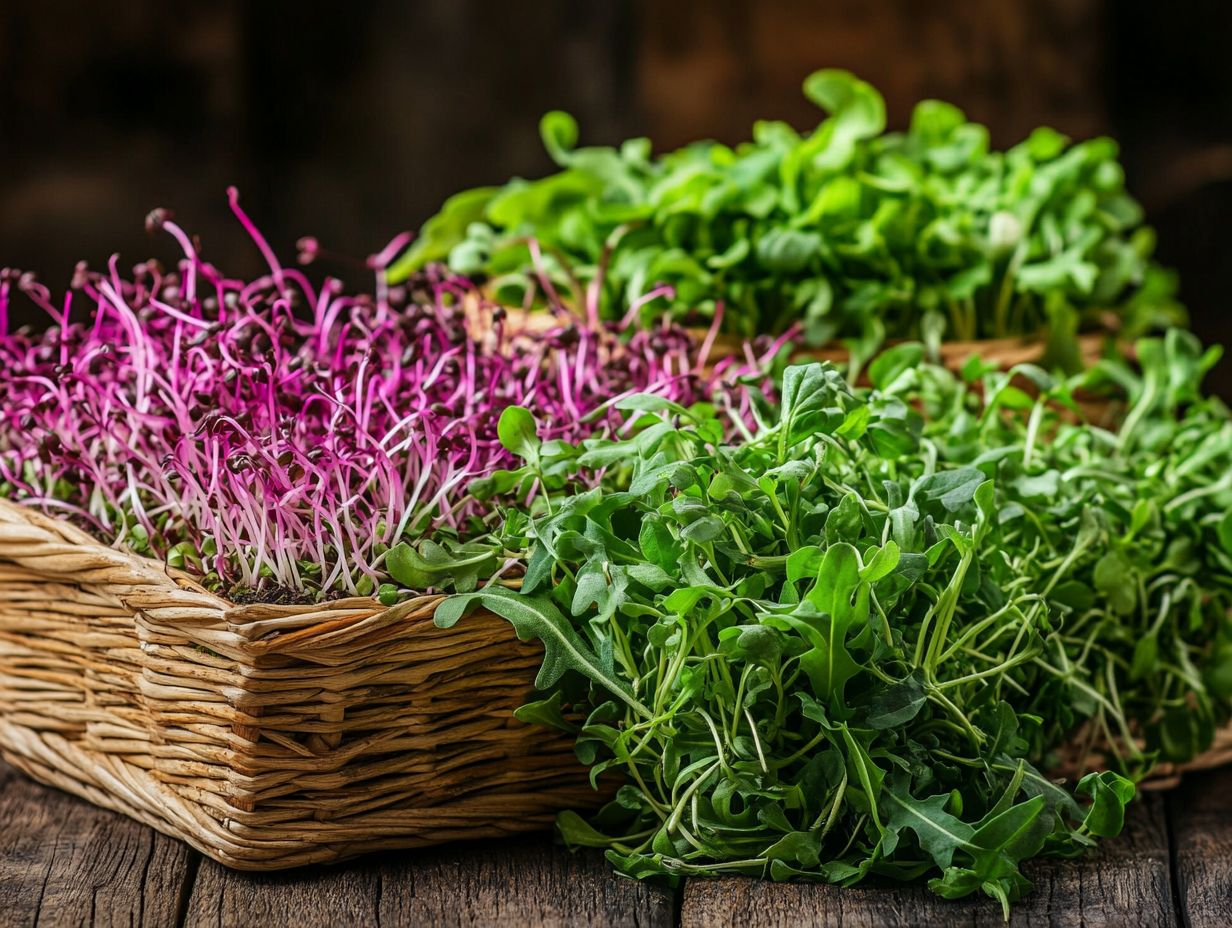
Microgreens elevate your cooking. They enhance flavor and nutrition, and they’re easy to store for later use.
These tiny powerhouses infuse a burst of freshness into salads, sandwiches, and soups, transforming each bite into something vibrant and delicious. With a simple storage method ideally in a cool, dry place or in a sealed container in the refrigerator you can ensure they retain their nutrient density and flavor for an extended period.
Don’t hesitate to experiment with different varieties, such as radish, basil, or pea shoots. They introduce exciting new dimensions to your meals. Whether you sprinkle them atop an omelet or incorporate them into a grain bowl, using microgreens enhances the visual appeal and adds a delightful crunch to your culinary creations!
Frequently Asked Questions
What are the best microgreens to grow for storage?
The best microgreens to grow for storage have a longer shelf life and can be preserved easily, such as kale microgreens, broccoli microgreens, radish microgreens, arugula microgreens, and cabbage microgreens.
Why are these microgreens considered the best for storage?
These microgreens have a hardier texture and can withstand being stored for longer periods without wilting or losing their nutritional value, making them excellent choices for home gardening enthusiasts.
How do I store microgreens for future use?
To store microgreens, first wash and dry them thoroughly. Then wrap them in a paper towel and place them in an airtight container or plastic bag. Store them in the refrigerator for up to a week. Indoor growing methods can also help maintain freshness.
Can I freeze microgreens for storage?
Yes, some microgreens like spinach and peas can be frozen for storage. However, it is best to blanch them in boiling water for a minute before freezing to preserve their color and texture, especially for microgreens like spinach and pea microgreens.
Do all microgreens have a long shelf life?
No, some microgreens have a shorter shelf life. For instance, cilantro and basil are best when consumed fresh.
These varieties, especially Genovese and Red Rubin basil, wilt quickly and lose flavor when stored.
Can I use stored microgreens in cooking?
Stored microgreens can definitely be used in cooking! They work well as a garnish or added towards the end of cooking.
This method helps preserve their taste and adds valuable nutrients, including vitamins A, C, K, iron, and manganese.

